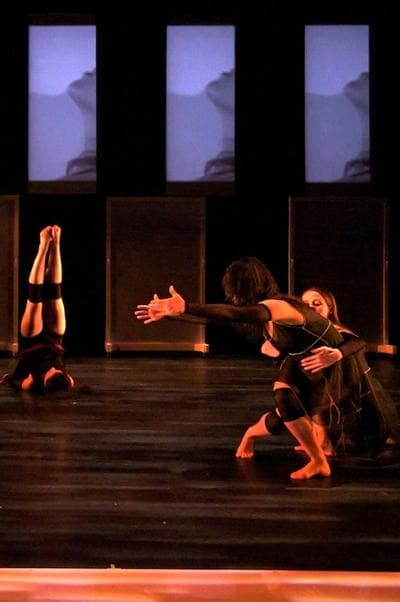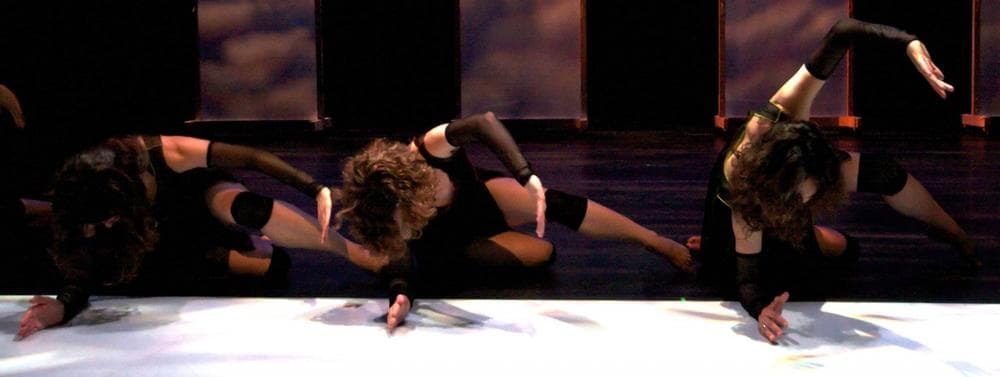Advertisement
Prometheus Dance Gets To The Heart Of The Matter

CAMBRIDGE — Diane Arvanites and I met the day after the Boston bombing. She’d invited me weeks earlier to sit in on a rehearsal at Cambridge’s charmingly crumbly Dance Complex in Central Square on that particular date. When I showed up, the dancers, stretching after a class, seemed a little jittery, and the accompanist was MIA. Arriving via the Central Square T station, policed that day by armed men in camouflage, I also felt a little shaky. Barefoot and earthy, Arvanites was a calm, composed presence, albeit with some sadness—though it was unclear whether that owed to the difficulties of the day or to the emotional acuity that comes through in her choreography.
Speaking about Prometheus Dance, the company she founded 25 years ago and now co-directs with Tommy Neblett, Arvanites described wanting dance to explore the range and variance of human emotion, the ups and downs, side by side, in a way that suggests she’s very attuned to both ends of that spectrum.
The company, per its website, aims to engage audiences “on multiple artistic levels, often with a platform of social statement and psychological intricacy.” The dances, the site reads, are “intimate, articulate, and provocative,” developed through “highly charged and visceral technical language.”
This Friday and Saturday, Prometheus will celebrate its 25-year anniversary by presenting a brand-new work in a two-day engagement at the Boston Conservatory Theater through World Music/CRASHarts. Titled “Heart of the Matter,” the hour-long piece is a “study of how former relationships affect the next relationship,” Arvanites says. “It’s also about stripping down the layers, the baggage that’s been collected over a period of time, to allow who you are to become who you were.”

The work begins with the company’s eight dancers—six women and two men—arranged in a kind of human machine, each moving in sync with the others, but facing outward in his or her own direction, contemplative, alone. One shakes another vigorously, and a third, on the other side of the machine, falls down, as if herself victim to the assault. This happens again, and again.
It’s ripple effect—or better, butterfly effect. We may all be alone, but we are also connected, and our actions have long-lasting consequences, results that may be deferred or transferred. We hurt one another whether, as the piece explores, in the name of love, or out of hate or disease or desperation, and the effects can be far-reaching. Someone is pushed, someone else falls.
Composed of both ensemble work and duets co-choreographed by Arvanites and Neblett with generous input from the dancers, “Heart of the Matter” clearly evokes the struggles and challenges and rewards of intimacy, without falling into the trap of getting too literal or theatrical.
One duet in particular, between Joe Gonzales and Kate Neal, particularly stood out at the rehearsal I attended. One of the great pleasures of modern and contemporary dance is its acceptance and juxtaposition of different body types, and Prometheus does it well. Gonzales, dark-skinned and burly, pairs with Neal, a powerhouse of palest, palest complexion, for the most athletic, explosive exchange I saw that day. The two face off in what appears a horrible fight, pushing, twitching, falling, intertwining. At the end, Neal’s bare knees, glowing painfully red, attested to the physicality of the work and her fearlessness as a dancer.
In contrast, a later duet between the company’s two male dancers, Gonzales and the company’s other, much smaller and wirier David Glista was soft and tender: gentle lifts and careful positioning, two figures working hard to support one another as best they can. Between the two duets was a lovely, quiet section featuring the company’s six women mostly in unison, at one point nested together like so many spoons. The work of healing falls not only to ourselves but to those we surround ourselves with.
We hurt one another whether, as the piece explores, in the name of love, or out of hate or disease or desperation, and the effects can be far-reaching. Someone is pushed, someone else falls.
The company’s dancers, all part-timers who balance twice-weekly class and rehearsal with jobs teaching, waitressing, or in other fields, are uniformly excellent. Some have been with the company for 15 years, some 10, some only a few, and most came via either the Boston Conservatory or Walnut Hill School, where Arvanites and Neblett teach modern dance technique, partnering, and choreography more than full time. “Everybody does other things in order to survive,” Arvanites says. “There’s no full-time paying modern dance company in this town.”
Arvanites was expressly grateful to CRASHarts for producing the performance, but said she’s “sad that there’s very little support” for companies like hers, and that even the kind of infrastructure that existed for supporting dance ten years ago has weakened.

This weekend is an opportunity to see and support a hard-working local troupe, clad in suits and ball gowns, premiere a work which, from the bits-in-progress I saw in my limited sneak preview, promises to be visceral, affecting, a welcome escape from, and diving into, life in all its messiness. After watching Prometheus rehearse for some time that day in April I realized I had become engrossed in the work in a less cerebral, more emotional way, and had quite forgotten what strangeness awaited all of us outside.
Kris Wilton is an arts writer and editor whose writing has appeared in Modern Painters, Art+Auction, ARTnews, Photo District News, Art New England, Slate, the Huffington Post, and the Village Voice, among other publications.
This program aired on May 16, 2013. The audio for this program is not available.